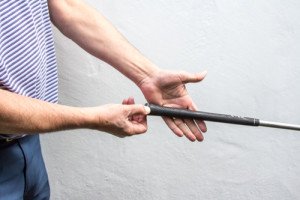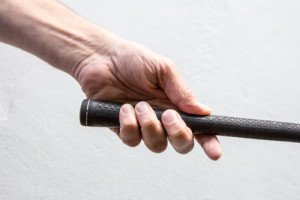The Golf Grip
The importance of a good golf grip cannot be over emphasized. It’s so important that we have separated it out from the rest of our golf swing information and put our information on the golf grip on it’s very own page.
Many of the most common golf mistakes—including the dreaded hook and slice—are exacerbated by a poor grip. While it is not true to blame all offline shots to a poor grip it is incredibly difficult to play reliable, consistent golf if you are gripping the club poorly.
Yes, we know that this is the boring part of golf. Trouble is that so many problems start here evern for the most experienced of golfers. It’s absolutely worth a few minutes to review your current grip and to make a few adjustments if required.
Checking Your Grip
As with so many other things in golf – it is often useful to get some knowledgable input from a third party – ideally your local pro. However, checking your grip for yourself is not difficult and something that you should do pretty regularly.
Grip Alignment
To check your grip look down at your hands as you hold your club in your normal stance. Make sure your feet and club are aligned with your target line just as if you were preparing to take a shot
As you look down you should see your left thumb running down the top of the shaft. There will be a “V” formed between the index fingers and the thumb of each hand. This “V” should be pointing at your right shoulder. If it isn’t, make adjustments to your hand position.
When making adjustments make sure your maintain your stance and keep the club aimed at the target. You must be sure you have moved your hands and not just rotated hands and club together. It is likely that your revised grip will feel uncomfortable – that’s normal – stick with it.
After making any required adjustments take up your normal stance. Once again look down at your hands.
How many knuckles of your left hand can you see?
For most golfers a neutral grip – with 1.5 to 2 knuckles showing – will deliver the best results.
Some golfers will have a stronger grip and may see 2 or more knuckles. Others may have weaker grips with only 1 knuckle showing.
In general terms a weak grip tends to be associated with fades and slices. As this will often mean loss of distance and poor direction weak grips should be adjusted as a matter of priority.
A strong grip is usually associated with players that draw or hook the ball. These are often perceived as better players. A draw is a more powerful shot than fades or even straight flight so may not need any adjustment. If you find you hook the ball fairly frequently then you should adjust your grip to a more neutral position.
If you hit the ball reasonably straight you should not change your grip. However, hitting the ball straight with a 3 or 4 knuckle grip is a sure sign of problems elsewhere in your swing.
To adjust your grip rotate your hands—not your club shaft, just your hands. Ensure the club face continues to point to the target while adjusting your grip.
You may find a simple hand position adjustment will reduce hooks, slices, or other problems. In my experience the changes will be relatively minor without the next truly magic ingredient.
Grip With the Fingers
There’s a very famous quote from an old fencing master on how tightly one should hold a sword:
“Remember the old principle. You must hold the grip as if you had a bird in your hand: gently enough not to crush it, but firmly enough not to let it escape.”
The same applies to the golf club. Many swing problems come about because we hold our clubs much too tightly and much too deep in the palm of the hand. A logical outcome of poor hitting is to hold the club ever tighter in an attempt to exert our control. Rather than fixing the problem this actually makes everything much worse.
Too tight a grip makes it much more difficult to stay loose and relaxed. A tight grip will also limit the ability to release the club head during impact limiting not only power but also control on the flight of the ball.
It is absolutely vital to a good golf swing that the club is gripped in the fingers and not in the palm of the hand.

The grip of the club should be along the line formed where the top joints of your second, third and fourth fingers meet your palm.
The exact positioning will depend on the club you are using. The shafts of your longer club will naturally be more vertical at address and will cross the line of your fingers and palm. The angle of the shaft of shorter clubs will mean they very naturally sit in the fingers.
Holding the club too tightly will restrict your movements during the swing. Holding it too loosely will limit the ability to complete the shot with full power and control.
If there is one thing that on its own can rapidly transform your golf swing it is ensuring that you always hold your club in your fingers and not your palms!
